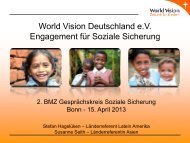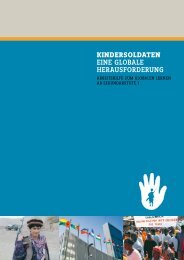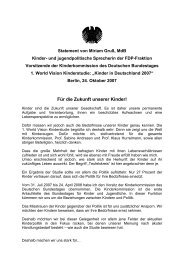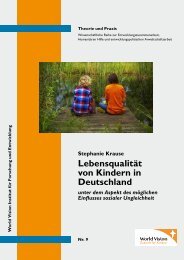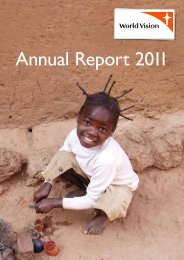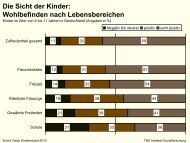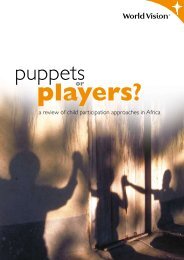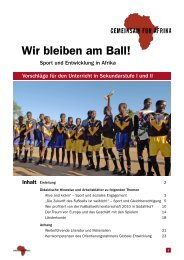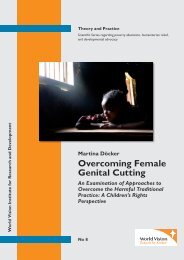Journalling for Peace - World Vision Institut
Journalling for Peace - World Vision Institut
Journalling for Peace - World Vision Institut
- No tags were found...
Create successful ePaper yourself
Turn your PDF publications into a flip-book with our unique Google optimized e-Paper software.
© <strong>World</strong> <strong>Vision</strong> International 2012ISBN 978-0-918261-34-2Authors: Elly Musafiri and Valarie Vat KamatsikoAll rights reserved. No portion of this publication may be reproduced in any <strong>for</strong>m, except <strong>for</strong> brief excerpts inreviews, without prior permission of the publisher.<strong>Journalling</strong> <strong>for</strong> <strong>Peace</strong>Children’s Energetic Voices on <strong>Peace</strong>, Conflict and <strong>Peace</strong>buildingNovember 2012<strong>World</strong> <strong>Vision</strong> <strong>Peace</strong>building Learning Centre &Center <strong>for</strong> Conflict Management of the National University of RwandaPublished by East Africa Regional Office on behalf of <strong>World</strong> <strong>Vision</strong> InternationalFor further in<strong>for</strong>mation about this publication or <strong>World</strong> <strong>Vision</strong> International publications, or <strong>for</strong> additional copiesof this publication, please contact wvi_publishing@wvi.org.<strong>World</strong> <strong>Vision</strong> International would appreciate receiving details of any use made of this material in training, researchor programme design, implementation or evaluation.Senior Editor: Heather Elliott. Production: Katie Klopman, Duncan Mutavi. Copyediting: Jo Marie Dooley.Proofreading: AY’s Edit. Cover Design and Interior Layout: Jim Asuke/Brandits Ltd.Cover photo © <strong>World</strong> <strong>Vision</strong>/ Albert Yu
ForewordAcknowledgements<strong>World</strong> <strong>Vision</strong>, in collaboration with the Center <strong>for</strong> Conflict Management of the National University of Rwanda, isdelighted to have worked with 118 children and youth to compile this report – the result of an innovative approachthat captured the thoughts and ideas of those who live with a legacy of conflict yet maintain the hope of peace.The <strong>Peace</strong> Journal Writing Initiative has proven to be an effective approach that not only raises participants’awareness about the issues surrounding them but builds their life skills <strong>for</strong> peace, enables them to marshal newenergy <strong>for</strong> peace, and presents a plat<strong>for</strong>m <strong>for</strong> participating children, youth and other actors to advocate <strong>for</strong> policiesand practices that promote sustainable peace.Aron, a child from Kivuruga Area Development Programme, expressed the following in the first stanza of his poem:The kind of peace Rwandans needSustainable peace among RwandansThe real peace that Rwandans needThe kind of peace Rwandans are longing <strong>for</strong>The children and youth have been amazing in their articulation of issues and workable solutions. Our call to allrelevant stakeholders is that children and youth should be given the space and support to be effective peacebuilders– which they have the potential to be. In addition, we call on all peace actors in Rwanda, including the Governmentat various levels, the international community, as well as community members – parents, guardians and childrenand youth themselves – to act on the recommendations highlighted in this report.We thank you, readers, <strong>for</strong> your relentless pursuit of a peaceful world.This report would never have been possible if it were not <strong>for</strong> the children who willingly participated in writing abouttheir experiences and reflections on peace, conflict and peacebuilding in peace journals. We deeply appreciatethese children – their commitment to the process, their unique insights and their ever-growing hope <strong>for</strong> sustainablepeace in Rwanda. We also appreciate the community members, parents and <strong>World</strong> <strong>Vision</strong> staff who walked withthe children as they worked hard to produce their journals.We are grateful to the review team members who further shaped the report. They included• Professor Paul Rutayisire – Director, Center <strong>for</strong> Conflict Management, National University of Rwanda• Rhoda Kasimbu – Regional Adviser, Child Protection and Child Focus, <strong>World</strong> <strong>Vision</strong> East Africa• Josephine Munyeli – Healing, <strong>Peace</strong>building and Reconciliation Specialist, <strong>World</strong> <strong>Vision</strong> Rwanda• Ulrike Krause – Technical Adviser, <strong>Peace</strong>building, and Point Person <strong>for</strong> Human Rights and Gender, <strong>World</strong> <strong>Vision</strong>GermanyIn addition, we acknowledge the ef<strong>for</strong>ts of Valarie Vat Kamatsiko, <strong>World</strong> <strong>Vision</strong> East Africa Region <strong>Peace</strong>buildingAdviser, who conceptualised the approach, oversaw the process and co-authored the report together with EllyMusafiri, a researcher with the Center <strong>for</strong> Conflict Management and lecturer at the Departments of DevelopmentStudies and Social Work (National University of Rwanda).We especially recognise the leadership of Professor Paul Rutayisire and George Gitau throughout the process andthe support of <strong>World</strong> <strong>Vision</strong> Canada and <strong>World</strong> <strong>Vision</strong> Germany.George GitauNational Director<strong>World</strong> <strong>Vision</strong> RwandaProfessor Paul RutayisireDirector, Center <strong>for</strong> Conflict ManagementNational University of Rwandaiiiii
List of abbreviationsContentsADPCCMECaPGLRNURPJWArea Development ProgrammeCenter <strong>for</strong> Conflict ManagementEmpowering Children as <strong>Peace</strong>buildersGreat Lakes RegionNational University of Rwanda<strong>Peace</strong> Journal WritingAcknowledgementiiiEXECUTIVE SUMMARY 2INTRODUCTION 5Rationale <strong>for</strong> the <strong>Peace</strong> Writing Initiative targeting children and youth 5The <strong>Peace</strong> Journal Writing Approach 6The focus of children’s peace journal entries 8ANALYSIS AND INTERPRETATION OF CHILDREN’S PEACE JOURNALS 9Overview of the content of children’s journals 9Children’s understanding of conflict and peace 9Children’s experiences and reflections on factors that impinge on peace 13Genocide and its consequences 13Gender-based violence 14Poverty as an obstacle to <strong>Peace</strong> 15Violation of children’s rights 16Land related conflicts 16Corruption 18Drug abuse and use of illicit brew 18Prostitution and sexual exploitation 19Other issues that undermine peace 20Children’s perspectives on what enhances peace in their families and communities 21What children are already doing and the role they can play to promote peace 22RECOMMENDATIONS 23APPENDIX A: Children’s <strong>Peace</strong> Poems 26APPENDIX B: Participation in <strong>Peace</strong> Journal Writing, by ADP 28REFERENCES 29List of diagramsDiagram 1: The peace journal writing approach 8Diagram 2: Children’s views on key components of peace 12Diagram 3: Conflict tree analysis of land conflicts in Rwanda 18List of boxesBox 1: Extract from guidelines to ensure safety during peace journal writing 7Box 2: Example of gender-based violence as promoted by some fathers 14Box 3: The effects of ‘sugar daddies’ 20iv1
Within the context of building sustainable peace in post-genocide Rwanda, participating children agree thatconstructive conflicts can promote critical and analytical thinking towards the process of peacebuilding andtolerance. To support this argument, Rachael from Kinihira ADP states, ‘It would be better if everybody couldstrive towards having constructive conflicts that work to improve their well-being, promote co-existence andwork towards a common good.’ In reference to children’s peace journals, constructive conflicts were said to berare in families and the different communities where they live. Children say this is so because Rwandan societyis still male-dominated and characterised by a lifestyle that does not promote dialogue in families. This is despitecommendable ef<strong>for</strong>ts by the Rwandan Government to promote gender equality. There is a correlation betweendialogue and constructive conflicts. There<strong>for</strong>e, absence of dialogue in families does not facilitate constructiveconflicts or even the sharing of ideas. The end result is that peacebuilding and socio-economic developmentprocesses progress at a slow pace.Both destructive and constructive conflicts involve the different values and beliefs that people have on differentaspects of social change. The difference is expressed in peoples’ actions or behaviours. They could be negativeactions – creating defensiveness which may also lead to a cycle of anger, fear, despair and isolation – or they couldbe positive actions creating openness to reach a resolution (Rachael, Kinihira ADP). Noticeable is that in thechildren’s communities, individuals and families experiencing such conflicts have values, behaviours and beliefsrooted in their social makeup as well as in the country’s history. For example, Dieudonne in Nyamagabe ADPargues that his village is characterised by destructive conflicts rooted in the ethnic and ideological beliefs accruedfrom Rwandan history and past conflicts. This is normal in human relations because conflicts are misunderstandingsin our perceptions towards our differing interests as human beings. Conflicts are inevitable in social change. 11In addition, children identified levels of conflict manifestation as inter-personal, intra-personal, regional andinternational. Valiste in Simbi ADP explains that inter-personal conflicts are based on a variety of issues relatedto power, social relationships and mistrust. Mistrust that emerges from a previous cordial relationship may leadto conflict. Issues related to power are associated with excessive demands and jealousy. Social issues that involvein-laws and politics lead to conflicts amongst people. Lack of affection amongst those who had a recent intimatefriendship may lead to disagreements that are irreversible (Petronille, Kinihira ADP). The traumatic experiencesby some genocide survivors lead to intra-personal conflicts (Cyprien ‘A’, Nyamagabe ADP 12 ). The child’s argumentis complex and relevant considering what women who suffered rape during the genocide and acquired HIV and/or those who got pregnant and gave birth endure. Such intra-personal conflict and suffering is part of life in postgenocideRwanda. Such experiences may even lead to inter-personal or inter-family conflicts.<strong>Peace</strong>According to their journals, peace is variously understood by different children. This is also the case <strong>for</strong> adultsand academics. The argument is whether peace can be universal or not. The general agreement is that peace iscontextual and dynamic as any other social process is. Galtung (1981) argues that in order to understand ‘whatpeace is, we should first understand what it is not’. 13 <strong>Peace</strong> is a many-sided process, 14 further justifying the differentdefinitions of peace by children.Clementine from Mudasomwa ADP understands peace as ‘a situation where people or countries have cooperationand unity amongst them.’ This is what Fisher, et al., calls ‘stable peace’. Although this understanding of peace may beacceptable to some people, the existence of cooperation and unity may not mean existence of peace <strong>for</strong> everyone.The argument is that peace is a process and is relative. According to Galtung, this is because, to some, peace is notharmony, peace is not stability and peace is not just conflict management. 15 On one hand, Noella in NyamagabeADP defines peace as ‘availability of security, basic needs like food, shelter and clothes, access to healthcare andfacilities and existence of good relations amongst people and nations’. This definition is in relation to the humanneeds theory which explains that deep-rooted conflict is caused by ‘unmet or frustrated basic human needs’such as physical, psychological and social, security, identity, recognition, and participation. 16 On the other hand,Jean de Dieu in Kisaro ADP argues that peace should be characterised by and defined in the context of ‘freedomof expression, unity, mutual support, social and economic development, and cooperation between people andamongst countries’.Some children defined peace in relation to Rwanda’s experiences of war and the 1994 genocide as well as inthe context of a developing nation. For example, Anicet in Kiramuruzi ADP defines peace as ‘resilience, unityand reconciliation as well as good governance and democracy’. As a child growing in the post-genocide era, hisdefinition holds meaning and substance to Rwandans; and indeed peacebuilding is a process involving a variety ofstrategies such as those highlighted in his definition. The child adds that ‘education is a catalyst to peace’, and that a‘person who secures a good education . . . fights to prevent conflicts’. In addition, Emmanuel in Kabuga ADP definespeace as ‘absence of poverty and domestic violence’.Similarly, Petronille from Kinihira ADP defines peace as ‘absence of violence amongst people and/or when someoneis having no problem both internally and in his/her surroundings.’ Clementine explains that peace ‘is when childrenfeel happy, and women express themselves and enjoy their rights’. The majority noted that in most families, childrenand women lack peace due to domestic violence – a topic that is discussed in detail in the following sections. <strong>Peace</strong>is a need by every human being despite differences in values or interests and behaviours.Children also demonstrated knowledge of conflicts beyond their national borders. Their discussions touchedregional and international conflicts. The regional conflicts discussed include conflicts in eastern DemocraticRepublic of Congo (DRC), Burundi, northern Uganda, the Darfur crisis and the Somali insurgency (Jean Paul,Nyamagabe ADP and Petronille, Kinihira ADP). The Arab Spring, Iraq and Afghanistan wars were some of theinternational conflicts highlighted by children (Jeanne, Karaba ADP).Children also had reflections on how peace could be built and consolidated. Jean Paul from Nyamagabe ADPemphasised that ef<strong>for</strong>ts to build sustainable peace in Rwanda should be ‘contextual to the country’s history andpost-genocide challenges’. What should characterise peace or what peace is in the Rwandan context was analysedby children in reference to the country’s history and post-genocide experiences. There<strong>for</strong>e, based on Diagram 2,children indicate that peacebuilding should be a process that promotes democracy, good governance, co-existence,reconciliation, unity, zero tolerance to violence and corruption, human respect and human rights, and fightingpoverty.11Lederach, J. P. (1997). Building <strong>Peace</strong>: Sustainable reconciliation in divided societies. Washington, DC: United States <strong>Institut</strong>e of <strong>Peace</strong> Press.12Where two child participants from the same ADP are quoted in this report, we distinguish them with ‘A’ and ‘B’.1013Galtung, J. (1981). ‘Social Cosmology and the Concept of <strong>Peace</strong>’. Journal of <strong>Peace</strong> Research, 17 (2), 141-301.14Fisher, et al. (2000).15Galtung (1981).16Fisher, et al. (2000).11
Diagram 2: Children’s views: Key components of peaceCultural respectHuman RightsObservanceHuman respectat the communal level commonly known as ‘abunzi’. 17 There is also unstructured facilitation by committees ofelders who sometimes make ef<strong>for</strong>t to resolve conflicts amongst parties through dialogue (Madeline, RugaramaADP and Innocent, Nyamagabe ADP). Four other children from different ADPs mentioned that other approachesused in conflict management and resolution are negotiation, mediation, settlement in courts and arbitration.Children’s experiences and reflections on factors that impinge on peaceReconciliationUnityRespect <strong>for</strong>women’s rightsNon-violencePEACE:CHILDREN’SPERSPECTIVESFreedom from povertyGender equalityLoveGood governanceThis section illuminates children’s experiences and reflections on factors they consider to be responsible <strong>for</strong> lack ofpeace in their families and communities. The section presents what children perceive to be the causes of conflictsand how conflicts manifest in their families, communities and schools. Issues that were common in children’sjournals include genocide and its consequences; gender-based violence including domestic violence, poverty-basedviolence, violation against children’s rights, land-related conflicts, corruption, and drug abuse, which is increasinglybecoming rampant amongst the youth. These are some of the key issues children considered to affect human peaceand security in their families, communities and nation.Genocide and its consequencesThe genocide in Rwanda in 1994 was experienced by the entire society directly or indirectly. The consequences inthe aftermath are felt by all categories of Rwandan society, including the survivors and perpetrators, those relatedto them, the young and the old, etc. The consequences are now becoming trans-generational. This presents someconstraints to building sustainable peace in the post-genocide era. As explained by Noella from Nyamagabe ADP:Mutual supportDemocracyCo-existenceToleranceLibertyOld people and children are living with the genocide consequences at the national, regional and internationallevel. People have no peace. Life is traumatic, challenging and not friendly. . . . Children were killed usingmachetes, some were drowned in rivers and pit latrines, and others were killed and left in the openterrains to be eaten by dogs.12Source: Chrispin, Kivuruga ADP; Uwamariya, Kivuruga ADP; Viateur, Ngenda ADP; JMV, Kisaro ADP; and Aimee Marie, Kisaro ADP.However, children also indicate the difficulties involved in achieving peace <strong>for</strong> all. As pointed out by Abel ofMudasomwa ADP, ‘There are people who want peace and there are people who do not wish others peace.’ Withthis reality, Abel adds that ‘there is a need to protect peace <strong>for</strong> those who already possess it’. This is because peaceis essential in human relations and <strong>for</strong> the development of families, communities and the country in general.People lack in<strong>for</strong>mation as well as knowledge on peace education and how peace should be achieved throughcollective responsibility and action. This is a big challenge <strong>for</strong> peacebuilding, reconciliation and socio-economicdevelopment (J. Claude, Rushaki ADP). There are few government institutions or civil society organisations thatteach peace education across the country. In addition, it is not yet included in the school curriculum – a movethat would have given more young people an opportunity to gain in<strong>for</strong>mation and knowledge about peace. Lack ofadequate peace education poses a challenge to future generations.Conflict managementConflict management has been defined in the children’s peace journals as means or approaches used to preventconflict escalation as well as those processes that facilitate conflict de-escalation. Schem In addition, Yvette inRugarama ADP explains conflict management as ‘means of de-escalating a conflict’. Children placed moreemphasis on dialogue between conflicting parties through government initiatives to promote conflict resolutionWith reference to the above quotation and drawing from the experiences from genocide commemorations heldevery year in April, fear and anxiety still linger amongst the children and the youth. This is attributed to genocidestories told by parents and other people, public lectures and in<strong>for</strong>mation from movies on the 1994 genocideshown during the commemoration period. Even genocide museums and memorial sites indicate how children werebrutally killed. Indeed, children killed their fellow children during the genocide. Children have the knowledge ofthis horrific experience and have not overcome it. Nevertheless, it is important <strong>for</strong> children, youth and the entiresociety to know about their history and about the genocide in order <strong>for</strong> them to understand the current situationand <strong>for</strong>ge a better future.Esperance from Nyamagabe ADP points out that ‘in the aftermath of the genocide, some families still have conflictsbecause of failure to <strong>for</strong>give one another’. Be<strong>for</strong>e the 1994 genocide, Rwandans at least experienced co-existenceand had some kind of peace, even amongst children. Today, some children of the survivors and perpetrators live inhatred. In some instances, children of both survivors and perpetrators cannot play together, as noted by Cyprien‘B’ from Nyamagabe ADP.To overcome the consequences of the genocide, Cyprien recommends that people should not be overridden byhistory. Instead, they should find what can help them in building sustainable peace as well as fostering unity andreconciliation. Noticing that the 1994 genocide against the Tutsi was planned by the leaders and implementedby a section of citizens, today the leaders should act as examples to the citizens in fighting genocide ideology(David, Nyamagabe ADP and Lilianne, Mudasomwa ADP). Once this ideology, which was used in perpetratingthe genocide, is deeply understood by both leaders and citizens, conflicts related to the 1994 genocidal as well assecurity related issues can be minimised (Aimable, Mudasomwa ADP).17Abunzi is an approach inspired by Rwandan traditional dispute resolution mechanisms through communal meetings. It is established by the Organic LawN 02/2010 of 09/06/2010.13
Violation of children’s rightsAccording to some children’s journals, violation of children’s rights is still rampant in both poor and rich homesteadsand poses a threat to the enjoyment of peace. Children asserted that child abuse is a common practice in somefamilies. For example, some children are denied the right to attend school in order to carry out domestic work(Violette, Mudasomwa ADP and Eric, Rushaki ADP). In reference to this, Lilianne from Mudasomwa ADP assertsthat ‘girls suffer this most’. Although committing mistakes is a common practice by any child, children mentionedthat they are punished <strong>for</strong> it. In some families when a child makes a mistake, he/she is disciplined not in a good waybut is beaten or <strong>for</strong>ced to carry out a task supposedly equivalent to the committed mistake (Gentille, NyaruguruADP). Such acts deny children inner peace and impact negatively on their development. For example, a child notedthat ‘hard labour done by children from poor families or orphans denies them peace and affects their mental orintellectual development’ (Micheal, Rebero ADP). Another <strong>for</strong>m of child rights violation is deliberate refusal toprovide food once a child commits a mistake. Children are also stopped from playing with others. According to Ericfrom Rushaki ADP, child sexual abuse, especially rape, remains a big challenge.Violette of Mudasomwa ADP adds that adopted orphans sometimes face discrimination by adults taking care ofthem, and in most cases this cruel treatment is done by female parents and guardians. Violette states that adoptedchildren are given more domestic work and house chores compared to other children in the family and are deniedaccess to education. In their peace journals, children did not discuss whether parents or other people who commitsuch child abuse are aware of children’s rights.The Rwandan Government has adopted a policy encouraging people to adopt children located in all orphanages inthe country. While the move is important in de-institutionalising child care and protection, it is imperative <strong>for</strong> thepolicy to consider how abuses such as those mentioned above could be eliminated.Holistically, Arroyo R., W. (2010) argues that ‘children’s rights need to be measured and monitored independentlyfrom other overall human rights because they constitute a vulnerable sector of the population that needs specialprotection’. 21 Such a mechanism exists in Rwanda but with no clear and specific national evaluative and monitoringindicators. Important to note is that in all the seven children’s summits that have been held annually, not a singlesummit recommended the establishment of a national index <strong>for</strong> promoting and defending children’s rights. AlthoughRwanda ratified the International Convention on the Rights of the Child and has domesticated it, the RwandaNational Commission <strong>for</strong> Children in the Prime Minister’s office lacks clear guidelines that are modelled to theconvention.Land-related conflictsLand-related conflicts are a serious issue all over the country. From the perspectives expressed in children’s peacejournals, these conflicts are largely a result of land scarcity and the way property inheritance – and particularly landinheritance – is handled. For example, Abel in Mudasomwa ADP notes that ‘land disputes between family membersare a major source of conflicts. People do fight over land issues’. Elysée in Karaba ADP adds that ‘people do killeach other due to unresolved land conflicts’.Clementine from Mudasomwa ADP asserts that ‘some people have been threatening other people’s lives over landwrangles’. Elysée explains that land inheritance practices have had a variety of negative consequences where ‘familymembers kill each other because of land conflicts’. She adds that:Sometimes such family conflicts go beyond these homesteads, leading to lack of peace in the neighbouringfamilies – in cases where neighbours become part of the conflict by supporting the different partiesinvolved. When a conflict escalates like this and each conflicting party has supporters, then it createsdivisions and hatred between conflicting parties and even amongst their respective supporters. This maylead to insecurity in the village or community.This indicates that a family issue may lead to disintegration of entire neighbourhoods. The secondary conflictingparties join in to support the primary conflicting parties. At this stage, a conflict takes a larger trend. To overcomesuch conflicts, Noella of Nyamagabe ADP recommends ‘setting up of committees in the villages to promoteresolution of land-related conflicts’.Cyprien ‘A’ from Nyamagabe ADP explains that when land or other properties are being distributed to childrenby parents, some children benefit more than others, thus creating conflicts, tension and hatred amongst familymembers. Because of this, some people have gone to the extent of committing murder. In some cases, youngchildren have become victims where they are denied the right to inherit land and other property. Consequently,when the victim grows up and finds out that he or she did not inherit anything, they get into disputes with theirelder brothers or sisters (Yvette, Rugarama ADP). In this case, many girls have been victims compared to boys.This is explained by Cyprien ‘A’ when he makes reference to a common saying which states that ‘there is no girlwho can inherit from her parents. Instead, she gets married and it marks the end’. This kind of perception is rootedin Rwandan culture and still influences inheritance decisions in some families. Certainly, where such practicesagainst girls still exist, girls enter into conflicts with their parent(s) or their brothers.Important to note is ‘Law N 22/99 of 12/11/1999 to supplement Book 1 of the civil code and to institute part fiveregarding matrimonial regimes, liberalities and successions’ which in Chapter II gives women and girls the right toinherit from their husbands and/or parents. A sensitisation campaign on this law was conducted, but it will takea long time to change the pre-existing culture. More needs to be done to ensure that such negative practices areeliminated.Land conflicts in Rwanda were also identified to be a key issue of concern by children from Nyamagabe, Rugaramaand Kinihira ADPs who participated in the ECaP Learning Event organised by <strong>World</strong> <strong>Vision</strong> in Kigali in April 2011.Using a conflict tree analysis tool, the children analysed the causes and effects of land conflicts as depicted inDiagram 3. According to this analysis, land conflicts in Rwanda are caused by giving birth to too many children;not having enough property to give to all children; ignorance; lack of knowledge on laws relating to propertyinheritance; having different ideas and interests in a family; divorce; and unequal treatment of children. The analysisindicates that land conflicts lead to injustices; violation of human rights; jailing of perpetrators; bewitching oneanother; deaths; division amongst siblings; street children; and generally increased burden on the country. Thesecauses and effects are similar to what is reflected in the children’s peace journals.1621Arroyo R., W.(2010). Measuring Children’s Human Rights Violations: Constructing an International Index of Children’s Human Rights. Departamento de CienciasSociales-Centro de Investigaciones Sociales Aplicadas, Universidad de Puerto Rico, Mayagüez. Retrieved 27 June 2012, from www.gnrc.net/en/aboutus/fourth<strong>for</strong>um/fourth<strong>for</strong>um_main.html.17
Diagram 3: Conflict tree analysis of land conflicts in RwandaDivision amongsiblingsViolation ofhuman rightsBurden tothe countryBeing jailedInjusticesStreetchildrenBewitchingone anotherDeathspoor relationships with peers, parents, family and other community members. As stated by Micheal from ReberoADP, ‘drugs kill our lives.’ Dieudonne from Nyamagabe ADP notes that the most affected age group is between 16and 25 years old. Jean Paul from Nyamagabe ADP argues that the lives of youth and especially those of street childrenare being endangered due to use of drugs like marijuana and cocaine. He adds that ‘drug consumers cause insecurityby fighting and stealing, thus undermining peace.’ He continues to explain that ‘drug consumers may be driven intoundesirable sexual behaviours which may lead to acquiring HIV’. To explain the reasons <strong>for</strong> this, Dieudonne mentionsthat ‘the youth have resorted to drugs as a way to relax and relieve boredom’. Some youth think that taking drugs is asolution to their problems not knowing that drugs create more challenging experiences in their lives (Micheal, ReberoADP). One of the consequences is that youth who consume drugs normally get into conflicts with their parents sincethey consider themselves to be grownups (Jeanne, Karaba ADP). Jeanne adds that sometimes such youth end upbeating their parents, their brothers or sisters – disrupting family peace and harmony.Not enough property,including land, to giveto all childrenLand ConflictsLack of knowledge onlaws on inheritanceInequality intreatment of childrenDivorceChildren share the same opinion with local and police authorities that producers and users of illicit brew are asource of insecurity amongst people. Dieudonne from Nyamagabe ADP notes that ‘these locally brewed drinks area source of crime and other insecurity-related practices such as fighting, killing, stealing and raping of children inthe villages’. The consequences are felt by both adults and children. For instance, raping of children by those underthe influence of illicit brew and drugs is becoming a common threat to children and entire communities. Generally,children who wrote on drug abuse and illicit brew in their peace journals do recognise that drug consumers mayengage in irresponsible behaviours that have negative consequences.Giving birth totoo many childrenIgnoranceDifferent ideasin a familyThe above conflict tree analysis shows a relationship between land issues raised by children in their peace journalsand those that were highlighted during the ECaP Learning Event conducted in Kigali in April 2011. This shows thatland conflicts in Rwanda are an issue that affects children in one way or the other and hinders progress towardssustainable peace.CorruptionCorruption is another challenge to peace as reflected in children’s peace journals. They indicated that wherecorruption is practised, it is an injustice to children’s families and there<strong>for</strong>e denies them peace. Dieudonne fromNyamagabe ADP asserts that ‘corruption is largely manifested in the judicial sector and at local administrativelevels’. It was pointed out that service delivery at some local administrative levels has been frustrated by corruption,especially at umudugudu 22 and cellule 23 levels. Eric from Rushaki ADP thinks that if parents have to bribe someonein order to get a service from the local administration, then people lose trust in their leaders, who as a result mayfeel insecure and this may cause tensions and conflict. If the service was related to solving children’s problems, thenthe children automatically become victims, thus disrupting their peace.Corruption in the judicial sector as well affects family well-being. Despite the policy of zero tolerance to corruptionby the Rwandan Government, it is still a threat to achieving sustainable peace and development. Dieudonne fromNyamagabe ADP again argues that corruption in the judicial sector is largely related to property cases and in particularto land. What this means is that when people are denied justice in property cases, this may lead to conflicts thatundermine peace.Children’s reflections on how these issues could be addressed to promote peace were insightful. Dieudonne arguesthat ‘if all citizens could collaborate with local authorities and the police, we can eliminate these illicit brews anddrugs that cause insecurity and disrupt peace’. He recommends that citizens should make it a practice to in<strong>for</strong>mconcerned authorities about those people who make illicit drugs in order to eradicate the production and sale ofthese substances in every community. As an approach to fighting the use of drugs and illicit brew, Jeanne from KarabaADP and Micheal from Rebero ADP suggest that mass sensitisation should be done to increase awareness about thedangers associated with use of these drinks and drugs. Becky from Kiramuruzi ADP recommends ‘establishment ofanti-drug clubs in schools’. She adds that ‘students should be taught about the dangerous consequences of drugs,and this must be part of the educational and school system’. She based her recommendations on her experience,which shows that ‘when there are students who take drugs at school, it becomes easy <strong>for</strong> other students to gettempted.’ For this reason, sensitisation is highly needed in schools.Prostitution and sexual exploitationProstitution is defined by Jeanne from Nyamagabe ADP as having sexual intercourse <strong>for</strong> money and it is committedby both adults and adolescents. Indeed, prostitution is increasingly becoming a way of social life amongst adults andyouth despite its illegality and adverse effects. Marthe from Rebero ADP argues that ‘the practice of prostitutionis one of the causes of conflicts and insecurity and sometimes leads to disintegration of families’. Jeanne fromNyamagabe ADP also adds that ‘prostitution causes insecurity and disrupts peace in a family or community setup’.Men who engage in sex with prostitutes end up having conflicts with their spouses – quarrels with their wivesor failure to buy food <strong>for</strong> the family (Marthe and Solange ‘B’ of Rebero ADP and Claire of Nyamagabe ADP).Prostitution mostly takes place in cities, towns, developing commercial centres and in streets (Jeanne, NyamagabeADP). Important to note is that prostitution can be dangerous to people’s health and well-being. Those whoengage in unprotected sex may contract sexually transmitted infections like HIV, syphilis and gonorrhoea (Marthe,Rebero ADP).18Drug abuse and use of illicit brewChildren indicated that drugs and illicit local brew are emerging threats to peace in Rwanda with potential to havehigh social and economic costs if not addressed. Youth involved in drug and alcohol abuse were said to often have22Umudugudu is the smallest local administrative unit in Rwanda.23Cellule is the second-largest local administrative level in Rwanda.Prostitution and sexual exploitation amongst married, divorced and widowed adults is taking another twist. ‘Sugardaddies’ and ‘sugar mammies’ are causing problems to the young generation. They do <strong>for</strong>ce young people intosexual intercourse and the outcomes can be devastating to the future of the youths involved – some becomepregnant and/or acquire sexually transmitted diseases (Solange ‘A’, Rebero ADP). Box 3 contains a short story fromher peace journal about ‘sugar daddies’.19
Box 3:The effects of “sugar daddies”Children’s perspectives on what enhances peace in their families and communitiesJanet (real name withheld), aged 15 years, was a secondary school student in senior three in 2010. She livedwith her grandmother in the village. Her parents lived in an urban area. During holidays, when she went tovisit her parents, she met a man who requested to know her names and where she resided. The girlresponded positively. The man expressed interest in having a relationship with her and in<strong>for</strong>med her that hewould be providing all she would need. The girl first hesitated as the man was as old as her daddy. In addition,the man gave her a gift—a cell phone with a dual simcard and fifty thousand Rwandan francs. The girlaccepted with much happiness.He also gave her his contact number and they agreed that they should be talking to each other regularly. Heeventually persuaded the girl and they finally met somewhere in a hotel, where a room was alreadyreserved. The man requested sexual intercourse and the girl refused. The man then told her to reimbursethe gifts. The girl had no option but to surrender to the request. After two months, the girl discovered thatshe was pregnant. After her family discovered that she was pregnant, they started harassing her. She couldnot take it anymore so she left her family. She now lives in misery, poverty and isolation. The “sugar daddy”messed her up. He robbed her of her peace and future.Source: Solange, Rebero ADP.‘Sugar daddies’ who go out with young girls have also suffered divorce in their families (Joyeuse, Nyamagabe ADP).With the above analysis, prostitution takes various <strong>for</strong>ms and leads to a variety of negative consequences such asbroken family relations, divorce, pregnancy and acquiring sexually transmitted diseases.Other issues that undermine peaceCrimes and other issues are increasingly happening in various parts of the country – both in the rural and urbanareas. These range from property theft to aggravated robbery leading to killings. These acts are sometimescommitted by gangs. D’arc from Byiringiro ADP notes that such acts are increasingly becoming a threat to people’ssecurity and peace. The child attributes the prevalence of such crimes to the increasing levels of unemployment andpersistent poverty, particularly amongst youth. Disasters were also identified to be robbing people of their peace.For instance, disaster unpreparedness creates instabilities and insecurity amongst the people (Sentia, ByiringiroADP). Heavy rains which lead to landslides that kill people and destroy shelters have disrupted people’s peaceand security as well as their welfare (Jean Paul, Nyamagabe ADP). Animals from Nyungwe National Park destroypeople’s crops, thereby causing hunger and poverty (Cyprien ‘A’ of Nyamagabe ADP). In addition, Cyprien notedthat poachers who routinely feast on animals in Nyungwe <strong>for</strong>est have fallen into conflict with the counter-offensivegame rangers. The <strong>for</strong>est is also encroached on by people in search of firewood <strong>for</strong> cooking (Sabel, NyamagabeADP). All these factors undermine individual, family, community and, at times, national peace.Children indicated that peace, in families and communities, is enhanced through <strong>for</strong>mal and in<strong>for</strong>mal approaches, whichinclude the following.<strong>Peace</strong>-promoting actions and behaviours by parents and other adult caregiversWithin their families, children mentioned that peace is enhanced by the parents’ togetherness, cooperation, harmony,and love and shaping of children’s behaviour. For example, Joyeuse from Nyamagabe ADP explains that peace is broughtby good relations between parents, daily prayers and social cohesion between extended family members. Appropriateshaping of children’s behaviour is regarded to be important to changing children’s mind-set towards peace. Accordingto Violette from Mudasomwa ADP, peace in families with adopted children is enhanced by ‘taking care of all childrenequally since there are many children who haven’t got a chance to be brought up by their own parents’. She argues that‘parenting all children equally, orphans inclusive, leads to sustainable peace <strong>for</strong> children, families and the communityin general’. In her understanding, she feels that every human being should be given the value they deserve so as toattain sustainable peace. Violette states that ‘trust is another element of promoting peace in families. Nurturing trustbetween family members is essential. It creates social cohesion’.In addition, a child noted that ‘families characterised by practices that promote gender equality in fulfilling their rolesand responsibilities tend to offer appropriate parental care and love which brings peace in families’ (Gentille, NyaruguruADP). In recognition of the ef<strong>for</strong>ts made by the Rwandan Government, Marthe from Rebero ADP notes that ‘genderrespect has brought peace between parents and children. . . . In our country there is gender respect and promotion.Women have been given their right to express themselves. They participate in political affairs and also give ideas indecision-making bodies. Even in families, children are increasingly being treated equally’. From the above, it is clearthat the younger generation has an understanding of the importance of better gender relations as a key component toaddressing gender-based violence, promoting women’s rights and achieving sustainable peace.With reference to the above, parents should be proactive and not reactive to shaping children’s behaviour – usingnon-violent approaches to addressing issues and disciplining children, enhancing children’s self-esteem as well as peaceattitudes and skills.Building on family connectors<strong>Peace</strong> amongst children and their families is strengthened by family celebrations that serve to connect family members,relatives and friends. For instance, Sentia from Byiringiro ADP explains that ‘celebrating birthdays by holding partiesbrings happiness to her and her family’. She adds that families who do not enjoy togetherness and collaboration do notnormally celebrate such events, yet it is what cements social cohesion in many families.Formal approachesChildren stated that ef<strong>for</strong>ts by the Government and its officials help promote peace at different levels. Abel fromMudasomwa ADP pointed out that ef<strong>for</strong>ts to fight corruption, nepotism and social injustice enhance peace at villageand sector levels. <strong>Peace</strong> is also promoted through unity and reconciliation programmes (Jeanne, Karaba ADP). Otheref<strong>for</strong>ts and approaches that enhance peace as pointed out by children are discussed in the ‘Conflict management’section of this report.2021
What children are already doing and the role they can play to promote peaceOver the years, it has become clearer that children and youth have a role to play in trans<strong>for</strong>ming their communities.This section draws from children’s peace journals and highlights what children are doing to help people live togetherin peace and describes the role they think they can play to promote peace. However, not many children focused onthese two aspects when writing their journals. This shows the need to have children participate more actively inpeacebuilding processes in their home, school, community and other places.Violette from Mudasomwa ADP provides an example of what young people are doing to promote peace in theircommunities.We went to assist a poor old woman near our school. After we finished, we held discussions with her aboutpeace, <strong>for</strong>giveness and conflict resolution. Amongst many issues we discussed, the old woman said that <strong>for</strong>her, she knows that ‘if you have a conflict with somebody, you cannot again communicate, that is the end’.After hearing her kind of thinking and reasoning, we explained to her according to how we were taught. . . .She requested us to come back. . . . When we went back, we again helped her to do some work and in theprocess we came back to our discussion. Fortunately, the old woman had changed her line of thinking andthat she had some knowledge of conflict resolution and peace.This example indicates that if children are provided with relevant peace knowledge and skills as well as theopportunity to contribute, they can become good agents of change. They can play a role in raising awarenessamongst their peers and adults.In addition, children are promoting peace through sports. Omar from Kinihira ADP explained that different sportsare an avenue through which they have been able to trans<strong>for</strong>m their own conflicts both at school and at home. Thisis achieved through organising sports competitions between schools or church dioceses, he added. In line with this,peace education through games can help people to become aware of their bias and the prejudice in them as wellas in their societies. 24 If well organised, sports are critical in encouraging youth’s participation in promoting peace.Children have also participated in peace campaigns in their villages. For example, Abel from Mudasomwa ADPgained knowledge on peace promotion campaigns that took place in his village in 2011. He believes that ‘such peacecampaigns are essential towards promoting human relations and development’. One of the messages disseminatedduring that peace campaign was that ‘the youth and children must act as examples by sensitising their friends andcolleagues about peace and showing them the path towards peace’. This means that once children are given theopportunity to be part of such events and processes, they can learn a lot from others, thereby acquiring relevantin<strong>for</strong>mation and knowledge as far as peace education is concerned.RECOMMENDATIONSThe following recommendations are drawn from children’s journals. They are based on the perspectives of youngpeople regarding conflict, peace and peacebuilding. The issues they highlighted as well as the suggestions they madedescribe how peace could further be built and how they should be meaningfully involved. Building on these, therecommendations take into consideration learnings from the commendable journey of peace in Rwanda and elsewhere.They also take into consideration the potential of children and youth as peacebuilders. Empowering and meaningfullyinvolving youth is a prerequisite to sustainable peace and development. Youth are not only victims of violence andconflict or security threats, they are strategic partners, peacemakers and drivers of positive change.To peace actors in Rwanda including the Government• Design peacebuilding policy and interventions that take on a multi-dimensional, multi-sectoral approach, taking intoconsideration the factors that impinge on peace as highlighted by children and youth – genocide and its consequences,gender-based violence, poverty, child rights violations, land-related issues, corruption, and other social issues suchas drug and alcohol abuse, especially amongst the youth. The importance of drawing the inter linkages betweenpeace and these factors is clearly painted by young people, and their perspectives should be central in any conflictand context analysis that in<strong>for</strong>ms policy and programming. Taking a multi-dimensional approach will contribute toachieving social justice, sustainable development, protection of rights including the rights of children, and ultimatelysustainable peace.• Recognise the specific impact of violence and conflict (both latent and overt) on poverty-fighting ef<strong>for</strong>ts, particularlyto alleviate child and youth poverty. The poverty-fighting agenda and strategies, such as the <strong>Vision</strong> 2020 and theEconomic Development and Poverty Reduction Strategy (EDPRS), should deliberately integrate conflict sensitivityand peacebuilding.• Enhance <strong>for</strong>mal and in<strong>for</strong>mal peace education ef<strong>for</strong>ts <strong>for</strong> children, youth and other community members.Formal and in<strong>for</strong>mal education measures that centre on building a culture of peace, skills in crisis prevention andpeacebuilding could foster the ideals of peace, justice, tolerance, solidarity, human rights and freedoms. This willhelp prevent violent conflict and rally young people to embrace progress and development. Make use of models andmethodologies that help children and youth to develop critical thinking, non-violent action, alternatives to violenceskills as well as other life skills <strong>for</strong> peace. With Rwanda’s education-<strong>for</strong>-all policy, peace education and peacebuildingshould be incorporated in the school curriculum and extra-curricular activities to target more children and youth inthe school system. Although the current curriculum incorporates civic education, it could be further strengthenedby integrating peace education.• Strengthen unity and reconciliation ef<strong>for</strong>ts at the local and national level to address the complex consequencesof the 1994 genocide and consolidate ‘never again’ ef<strong>for</strong>ts. Bridges of reconciliation need to continuously bebuilt through learning responsible and well-managed commemoration of the genocide that facilitates healing andrestoration of hope as well as safe plat<strong>for</strong>ms <strong>for</strong> dialogue and critical reflection on the past and present to constructa sustainable and peaceful future. The ef<strong>for</strong>ts of the National Unity and Reconciliation Commission at the nationallevel are applauded. Similar energy is needed at the local level <strong>for</strong> more coordinated plat<strong>for</strong>ms <strong>for</strong> dialogue andother initiatives that promote unity and reconciliation.2224See Fisher, et al. (2000).• Strengthen child and youth participation in inclusive peace clubs, associations and voluntary social movementsthat link horizontally and vertically to genuinely incorporate children and youth in peacebuilding ef<strong>for</strong>ts andprocesses. Well-designed peace clubs and associations are a means of organising and mobilising children andyouth <strong>for</strong> a shared mission of promoting peace as well as a systematic approach to enhancing young people’s23
peace knowledge, skills, attitudes and values. While horizontal linkages can help strengthen the voices of childrenand other young people by drawing from broad participation, vertical linkages are necessary to bridge voices ofchildren from the local level to the national level.• Invest in sexual health education <strong>for</strong> children and youth, communicating to both boys and girls that our sexuality andfertility are cherished gifts. Emphasis should be placed on the life skills approach, which aims at enhancing the abilityof children and youth to take responsibility <strong>for</strong> making healthier choices, resisting negative pressures and avoidingrisky and premature behaviour.To community members including parents, guardians, children and youth• Make every ef<strong>for</strong>t to create conditions that promote constructive dialogue as an instrument <strong>for</strong> preventing violentconflict and <strong>for</strong> conflict trans<strong>for</strong>mation in families and communities. Such ef<strong>for</strong>ts should aim at building trust,promoting consensus building and working towards common goals. Not only do families and communities thatconstructively deal with issues in non-violent ways promote healthy relationships and model good practice <strong>for</strong>children and youth, but they also rein<strong>for</strong>ce conflict prevention and trans<strong>for</strong>mation ef<strong>for</strong>ts at the national level.• Adopt positive parenting and non-violent disciplining of children. Such methods and techniques should provideparents and other caregivers opportunities to give guidance to children while listening to them, encourage children’sparticipation in finding solutions and build children’s skills to solve problems without violence.• Actively engage in development processes and activities at family and community levels to promote family well-being,including the ability to meet children’s basic needs. As recommended by Claudine from Karaba ADP, ‘We shouldremove our hands from our pockets so as to work very hard. We also need to fight illiteracy and to work throughcooperatives.’Parents and other community adults are encouraged to actively engage with child and youth peace activities to increasetheir appreciation of what children can do. The necessary support and cooperation required from parents and otheradults by children may include but not be limited to allowing them/granting them permission to participate; providingappropriate guidance; giving them space to explore, <strong>for</strong>m and express what they know and want; listening to them andtaking their views into account; supporting them with logistics; and participating in their activities as necessary.To the international community• Explore policy and programme frameworks that will help trans<strong>for</strong>m the way the international community engagesyoung people in conflict, fragile and humanitarian contexts. Strengthen the mainstreaming of youth perspectivesin peace processes and their involvement in peace and security processes. The United Nations should adopt aresolution on youth, peace and security and recognise youth as a special group in the United Nations context.• Integrate young people – male and female – into decision-making processes at local, national and international levels.Youth have unique perspectives on issues and how they can be resolved. Youth participation in decision-making atall levels promises sustainable solutions since this gives them an opportunity to be part of the present and shapingthe future.• Raise awareness within the international community of the importance of meaningful youth participation in peaceand security processes and thereby trans<strong>for</strong>m the way youth contribute to lasting peace and security. This shouldinclude promoting the active participation of young people in all aspects of life to ensure prospects <strong>for</strong> peaceful anddemocratic social change.• Make an ef<strong>for</strong>t to trans<strong>for</strong>m social norms, values and practices that contribute to discrimination and violence againstchildren. Amongst other things, children specifically pointed out practices that discriminate against and promoteviolence against girls and women as well as vulnerable children such as orphans: polygamy, domestic violence andother <strong>for</strong>ms of gender-based violence. Inculcate a culture that attributes equal value to both girls and boys – givingthem equal opportunity to develop socio-economically, psychologically and mentally, including practices thatpromote the rights of girls, women and very young children to inheritance.• Avoid getting involved in drug and alcohol abuse. Communities and schools should invest in initiatives to raiseawareness of children and youth about the dangers and consequences of drug and alcohol abuse. As suggested bysome children, community members should collaborate with local authorities and police to stamp out the supply anduse of such substances. Parents and other caregivers should strongly condemn drug use as well as positively influencechildren and youth by setting a good example.• Encourage children and youth to participate in activities and programmes that build their knowledge, skills,attitudes and values <strong>for</strong> peace. These could be organised at schools, in your communities, religious institutions,clubs and associations. Use the knowledge and skills to positively influence your peers and others around you asyour contribution to building unified, reconciled and peaceful communities. Engage in activities that give you anopportunity to use your time constructively. Be mindful that your right to participate comes with responsibilities.24• Support and encourage child and youth peace activities. Oftentimes, parents and other adults do not providethe required support because they have limited understanding of the role children can play and their capacity tocontribute. Experience has shown that adults who come into contact with children’s activities are often surprisedabout the capacity children have to accomplish things.25
Appendix A: Children’s <strong>Peace</strong> PoemsThat Is <strong>Peace</strong>by Uwamariya, Kivuruga ADPThe Kind of <strong>Peace</strong> Rwandans Needby Aron, Kivuruga ADPI. The kind of peace Rwandans needSustainable peace among RwandansThe real peace that Rwandans needThe kind of peace Rwandans are longing <strong>for</strong>Rwandans need plenty of peaceII.If we say peace, there are some who thinks that it is living individually peacefullyNo. No. <strong>Peace</strong> has many connotations<strong>Peace</strong> is characterised by love<strong>Peace</strong> is characterised by mutual support<strong>Peace</strong> should be characterised by good human behavioursIII. Rwandan children, come we find peaceWill not find peace amongst your relatives only<strong>Peace</strong> will be attained if both the young and adults work <strong>for</strong> itReal peace can be attained through different angles and through collective togetherness<strong>Peace</strong> in our ‘Gasabo’ 25 should be characterised by love and mutual support amongst all RwandansIV. Let us co-existLet us own tranquillityLet us open our gatesLet us love our countryV. Let us share bullsLet us uphold childrenLet us support orphansLet us make our ends meetLet us speak peace in our homelandI. All children let us all love one anotherLet us join dialogue groups <strong>for</strong> peaceAnd we discuss what we all admireDenounce what we dislikeThat is the peace we admireII.By loving your fellow childHelping him/her in solving problemsIn the future, he/she will do the sameLet us share the available resourcesThat is the peace we admireIII. <strong>Peace</strong> is good<strong>Peace</strong> brings friends<strong>Peace</strong> enables co-existenceWith peace, those who cannot share, they can shareThat is why, I say, let peace prevailRwandans Should Adhere to <strong>Peace</strong>by Telesphore, Kinihira ADPI. Rwandans, RwandansLet us build peaceRwandan citizens need peaceLife becomes meaningful in the presence of peaceII.Children, AdultsLet us strive to build peaceFor the betterment of our countryFor the future of our countryIndeed, children are the country’s futureIII. Let Rwanda be an example to the international communityBy building peaceThrough children’s initiatives of peacebuildingThat is what Rwandan children needIV. All children were created with humanityChildren dislike conflictsChildren need parents’ support in peacebuildingParents should teach us peace and humanityParents should not lead us into conflicts2625In the historical context, Rwanda was originally Gasabo be<strong>for</strong>e its territorial expansion. Many Rwandans prefer using the term to mean Rwanda.V. Children must be independent from conflicting adultsParents should act as examplesChildren need to inherit trans<strong>for</strong>mative behaviours from parents and grandparentsWe need to learn the culture of peace27
APPENDIX B.Participation in <strong>Peace</strong> Journal Writing, by ADPREFERENCESArea Development ProgrammeNumber of childrenByiringiro 17Kabuga 4Karaba 3Kinihira 10Kiramuruzi 3Kisaro 4Kivuruga 5Mudasomwa 5Ngenda 4Nyamagabe 18Nyaruguru 5Rebero 5Rugarama 11Rushaki 2Rutare 2Simbi 6Ubumwe 14TOTAL 118Arroyo R., W. (2010). Measuring Children’s Human Rights Violations: Constructing an International Index of Children’sHuman Rights. Departamento de Ciencias Sociales-Centro de Investigaciones Sociales Aplicadas, Universidadde Puerto Rico, Mayagüez. Retrieved 27 June 2012, from www.gnrc.net/en/aboutus/fourth<strong>for</strong>um/fourth<strong>for</strong>um_main.html.El Jack, A. (2003). Gender and Armed Conflict: Overview Report. London: <strong>Institut</strong>e of Development Studies.Fisher S., Ludin J., Williams S., Arbi I. D., Smith R. & Williams S. (2000). Working with Conflict: Skills and Strategies<strong>for</strong> Action. London: Zed Books.Galtung, J. (1981). ‘Social Cosmology and the Concept of <strong>Peace</strong>,’ Journal of <strong>Peace</strong> Research, 17 (2), 141-301.Gillis, E. (2005). Children as <strong>Peace</strong>builders: Trans<strong>for</strong>ming Conflict by Restoring the Potential of Youth,http://www.cda-cdai.ca/cdai/uploads/cdai/2009/04/gillis01.pdf, accessed November 2011.Global Network of Religions <strong>for</strong> Children (GNRC) Fourth Forum, Ending Poverty, Enriching Children. The GNRCFourth Forum took place 16–18 June 2012, Dar-es-Salaam.Human Rights Watch (2003). Lasting Wounds: Consequences of Genocide and War <strong>for</strong> Rwanda’s Children.New York: Human Rights Watch.Kamatsiko, V. (2006). Their Future in Our Hands: Children Displaced by Conflicts in Africa’s Great Lakes Region.<strong>World</strong> <strong>Vision</strong> Africa.Kelly, J. (2010). Rape in War: Motives of Militia in DRC. Washington, DC: United Nations <strong>Institut</strong>e of <strong>Peace</strong>.Lederach, J. P. (1997). Building <strong>Peace</strong>: Sustainable Reconciliation in Divided Societies. Washington, DC: United States<strong>Institut</strong>e of <strong>Peace</strong> Press.The Republic of Rwanda, National Youth Policy, Ministry of Youth, Culture and Sports, http://www.nyc.gov.rw,accessed 28 September 2012.The Republic of Rwanda, Law N° 22/99 of 12/11/1999 to Supplement Book 1 of the Civil Code and to <strong>Institut</strong>e PartFive Regarding Matrimonial Regimes, Liberalities and Successions, Official Gazette of the Republic of Rwanda,J.O. N 22 of13/11/1999, 15 November 1999.Schirch, L. (2008). ‘Strategic <strong>Peace</strong>building – State of the Field’, <strong>Peace</strong> Prints: South Asian Journal of <strong>Peace</strong>building, 1/1.Schirch, L. & Sewak, M. (2005). The Role of Women in <strong>Peace</strong>building. Conflict Trans<strong>for</strong>mation Programme, EasternMennonite University, USA.Sikoska, T. & Solomon, J. (2004). ‘Introducing Gender in Conflict and Conflict Prevention: Conceptual and PolicyImplications’. In David C. & Schnabel A. (Eds), Conflict Prevention from Rhetoric to Reality. Vol. 2, 637-678, LanhamMD: Rawman and Littlefield Publishing, Inc.UNESCO, Constitution of the United Nations Educational, Scientific and Cultural Organisation as Adopted inLondon on 16 November 1945 and amended by the General Conference at its 2nd, 3rd, 4th, 5th, 6th, 7th, 8th,9th, 10th, 12th, 15th, 17th, 19th, 20th, 21st, 24th, 25th, 26th, 27th, 28th, 29th and 31st sessions.Wedge, J. (2008). Where <strong>Peace</strong> Begins: Education’s Role in Conflict Prevention and <strong>Peace</strong>building. London: InternationalSave the Children Alliance.<strong>World</strong> <strong>Vision</strong> International (2012). A Tree Bent Young, Experiences and Promising Practices from Empowering Children as<strong>Peace</strong>builders (ECaP) Hubs of Learning, authored by Valarie Vat Kamatsiko, <strong>World</strong> <strong>Vision</strong> East Africa <strong>Peace</strong>buildingLearning Centre.<strong>World</strong> <strong>Vision</strong> International (2011). Guidelines <strong>for</strong> Empowering Children and Youth as <strong>Peace</strong>builders, authored by ValarieVat Kamatsiko, <strong>World</strong> <strong>Vision</strong> East Africa <strong>Peace</strong>building Learning Centre.<strong>World</strong> <strong>Vision</strong> International (2010). ‘<strong>Peace</strong>building and Reconciliation: Empowering Children as <strong>Peace</strong>builders’. A<strong>World</strong> <strong>Vision</strong> Project Model, draft version <strong>for</strong> field testing.2829
WVI identity statement<strong>World</strong> <strong>Vision</strong> is a Christian relief, development and advocacy organisationdedicated to working with children, families and communities to overcomepoverty and injustice. Inspired by our Christian values, we are dedicated toworking with the world’s most vulnerable people.<strong>World</strong> <strong>Vision</strong> serves all people regardless of religion, race, ethnicity or gender.
Contact<strong>World</strong> <strong>Vision</strong> East Africa Regional OfficeKaren Road, off Ngong RoadP. O. Box 133 - 00502Karen, Nairobi, KenyaTel: +254-20-883<strong>World</strong> <strong>Vision</strong> - RwandaP. O. Box 1419Kacyiru SudTel: +250-511772, 585329www.wvi.org‘Our vision <strong>for</strong> every child, life in all its fullness.Our prayer <strong>for</strong> every heart, the will to make it so.’



